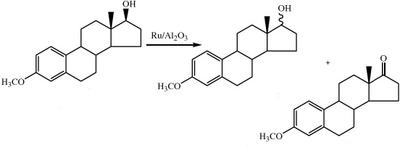
The above reaction shows an epimeric steroid alcohol being converted by a catalyst of ruthenium and aluminum oxide to a racemic mixture of 17-estradiol 3-methyl ether and a ketone. The racemic mixture is formed by converting the beta version of the ether, where the hydroxyl group is on the top of the ring, to the alpha version of the ether, where the hydroxyl group is underneath the ring. The reaction is stopped when the amount of alpha ether is roughly equivalent to the amount of beta ether. In the notation used, the wavy line between the hydroxyl group and the ether shows that the hydroxyl group can be in either the front or the back of the molecule.
However, a ketone can be produced instead of the alpha ether when the alcohol is oxidized. Because the purpose of the reaction is to racemize the ether, this ketone is an unwanted side product. To prevent oxidation, toluene at 100 C is used as a solvent. The chemical properties of toluene slow the formation of the ketone so that at temperatures around 100 C, the yield of the racemic mixture is about 54%. Any ketone that does form can be separated from the ether by flash chromatography. This reaction is a good way to racemize the ether efficiently and inexpensively; it was traditionally synthesized at a much higher cost.
For the full text of the article describing this process, see this report.
Wednesday, August 6, 2008
Production of ketone from an alcohol: an unwanted side product chymistry
Labels:
chemistry info
Subscribe to:
Post Comments (Atom)
No comments:
Post a Comment